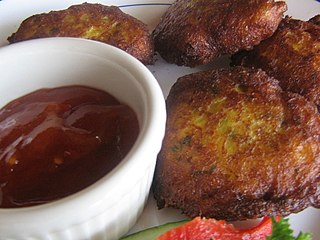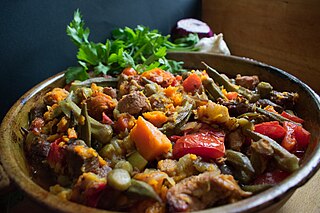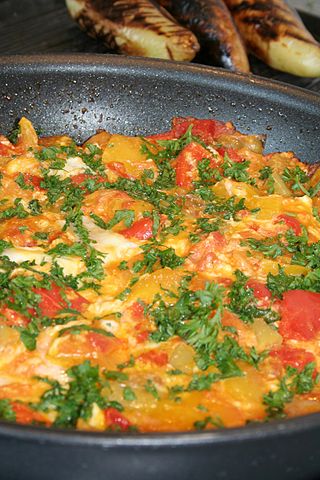
Turkish cuisine is the cuisine of Turkey and the Turkish diaspora. The cuisine took its current form after numerous cultural interactions throughout centuries, descending from earlier stages of Turkish cuisine, Ottoman cuisine and Seljuk cuisine. Turkish cuisine with traditional Turkic elements such as yogurt, ayran, kaymak, exerts and gains influences to and from Mediterranean, Balkan, Middle Eastern, Central Asian and Eastern European cuisines.

Moussaka is an eggplant (aubergine)- or potato-based dish, often including ground meat, which is common in the Balkans and the Middle East, with many local and regional variations.

Ajvar is a condiment made principally from sweet bell peppers and eggplants. The relish became a popular side dish throughout Yugoslavia after World War II and remains popular in Southeast Europe.
Romanian cuisine is a diverse blend of different dishes from several traditions with which it has come into contact, but it also maintains its own character. It has been influenced mainly by Turkish but also a series of European cuisines in particular from the Balkan Peninsula and Hungarian cuisine as well as culinary elements stemming from the cuisines of Central Europe.

Iraqi cuisine is a Middle Eastern cuisine that has its origins in the ancient Near East culture of the fertile crescent. Tablets found in ancient ruins in Iraq show recipes prepared in the temples during religious festivals—the first cookbooks in the world. Ancient Iraq's cultural sophistication extended to the culinary arts.

Chili sauce and chili paste are condiments prepared with chili peppers.

Lyutenitsa, ljutenica or lutenica, is a vegetable relish or chutney in Bulgarian, Macedonian and Serbian cuisines.

Pindjur or pinjur or pinđur, is a relish form and is commonly used as a summer spread. Pindjur is commonly prepared in Bosnia and Herzegovina, Croatia, Bulgaria, Serbia and North Macedonia.

Stuffed peppers is a dish common in many cuisines. It consists of hollowed or halved bell peppers filled with any of a variety of fillings, often including meat, vegetables, cheese, rice, or sauce. The dish is usually assembled by filling the cavities of the peppers and then cooking.

Muhammara or mhammara is a spicy dip made of walnuts, red bell peppers, pomegranate molasses, and breadcrumbs. It is associated with Aleppo, but is also found in Turkey, especially in southeastern regions, where Arab dishes are more common in the local cuisine because of the Syrian cultural influence, as well as in Western Armenian cuisine. In Turkey, muhammara is referred to as acuka and is served as part of the mezze platter appetizer course.

Many cuisines feature eggplant salads and appetizers.

Kyopolou is a popular Bulgarian and Turkish spread, relish and salad made principally from roasted eggplants and garlic.

Baigan bharta, also spelled bainganbharta or baigan chokha is an Indian dish prepared by mashing or mincing grilled eggplant (baigan) with tomato, onion, herbs and spices, with variations being common from chef to chef. Traditionally, cooking the eggplants over charcoals, inside of a tandoor, barbecue grill or oven, or even directly applying flame to the outside of the fruit infuses the dish with a smoky flavour; the blackened skin is then easily peeled and the eggplant may be further prepared.

Mizrahi Jewish cuisine is an assortment of cooking traditions that developed among the Mizrahi Jewish communities of the Middle East, North Africa and Central Asia. Influenced by the diverse local culinary practices of countries such as Morocco, Libya, Egypt, Iraq, Iran, Yemen, and Syria, Mizrahi cuisine prominently features rice, legumes, meats, and an array of spices such as cumin, turmeric, and coriander. Signature dishes include kubbeh (dumplings), pilafs, grilled meats, and stews like hamin.

Nam phrik is a type of Thai spicy chili sauce typical of Thai cuisine. Usual ingredients for nam phrik type sauces are fresh or dry chilies, garlic, shallots, lime juice and often some kind of fish or shrimp paste. In the traditional way of preparing these sauces, the ingredients are pounded together using a mortar and pestle, with either salt or fish sauce added to taste.
Romani cuisine is the cuisine of the ethnic Romani people. There is no specific "Roma cuisine"; it varies and is culinarily influenced by the respective countries where they have often lived for centuries. Hence, it is influenced by European cuisine even though the Romani people originated from the Indian subcontinent. Their cookery incorporates Indian and South Asian influences, but is also very similar to Hungarian cuisine. The many cultures that the Roma contacted are reflected in their cooking, resulting in many different cuisines. Some of these cultures are Middle European, Germany, Great Britain, and Spain. The cuisine of Muslim Romani people is also influenced by Balkan cuisine and Turkish cuisine. Many Roma do not eat food prepared by a non-Roma.

Türlü is a casserole of Turkish cuisine. It is made of stewed vegetables and may also include stewed meat. Varieties of this dish are also found in Balkan cuisines. In particular, it is known as turli perimesh in Albania, tourlou or tourlou tourlou in Greece, and as turli tava in North Macedonia.

Mish-mash is a Bulgarian spring dish made with fresh vegetables, eggs and sirene, and often garnished with freshly cut parsley. There are variations in which garlic, scallions, eggplant, okra or carrots are added to the dish. There are variations without sirene and without onion as well.


















